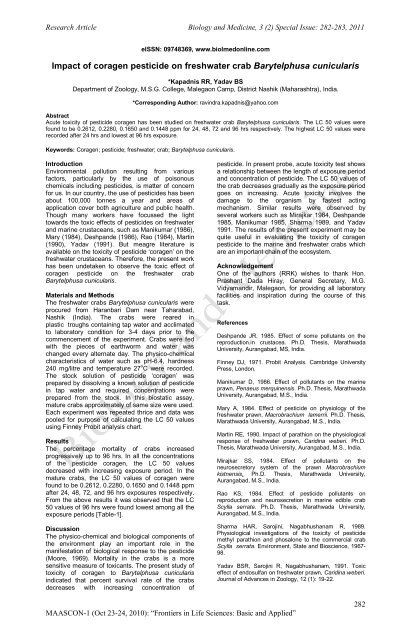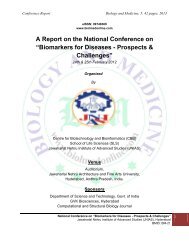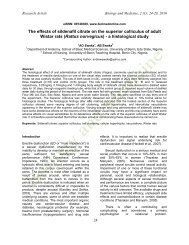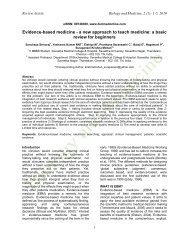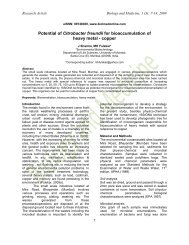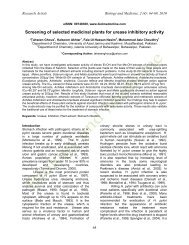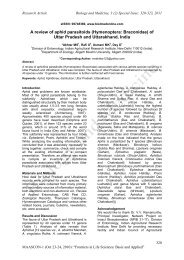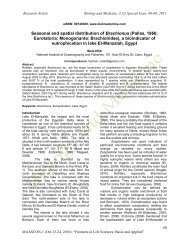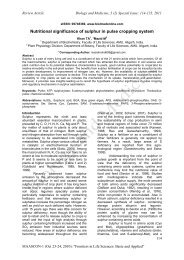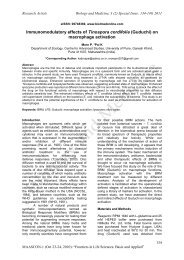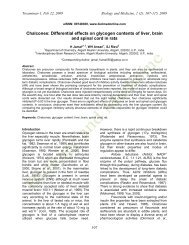Impact of coragen pesticide to freshwater crab - Biology and Medicine
Impact of coragen pesticide to freshwater crab - Biology and Medicine
Impact of coragen pesticide to freshwater crab - Biology and Medicine
Create successful ePaper yourself
Turn your PDF publications into a flip-book with our unique Google optimized e-Paper software.
Research Article <strong>Biology</strong> <strong>and</strong> <strong>Medicine</strong>, 3 (2) Special Issue: 282-283, 2011<br />
eISSN: 09748369, www.biolmedonline.com<br />
<strong>Impact</strong> <strong>of</strong> <strong>coragen</strong> <strong>pesticide</strong> on <strong>freshwater</strong> <strong>crab</strong> Barytelphusa cunicularis<br />
*Kapadnis RR, Yadav BS<br />
Department <strong>of</strong> Zoology, M.S.G. College, Malegaon Camp, District Nashik (Maharashtra), India.<br />
*Corresponding Author: ravindra.kapadnis@yahoo.com<br />
Abstract<br />
Acute <strong>to</strong>xicity <strong>of</strong> <strong>pesticide</strong> <strong>coragen</strong> has been studied on <strong>freshwater</strong> <strong>crab</strong> Barytelphusa cunicularis. The LC 50 values were<br />
found <strong>to</strong> be 0.2612, 0.2280, 0.1650 <strong>and</strong> 0.1448 ppm for 24, 48, 72 <strong>and</strong> 96 hrs respectively. The highest LC 50 values were<br />
recorded after 24 hrs <strong>and</strong> lowest at 96 hrs exposure.<br />
Keywords: Coragen; <strong>pesticide</strong>; <strong>freshwater</strong>; <strong>crab</strong>; Barytelphusa cunicularis.<br />
Introduction<br />
Environmental pollution resulting from various<br />
fac<strong>to</strong>rs, particularly by the use <strong>of</strong> poisonous<br />
chemicals including <strong>pesticide</strong>s, is matter <strong>of</strong> concern<br />
for us. In our country, the use <strong>of</strong> <strong>pesticide</strong>s has been<br />
about 100,000 <strong>to</strong>nnes a year <strong>and</strong> areas <strong>of</strong><br />
application cover both agriculture <strong>and</strong> public health.<br />
Though many workers have focussed the light<br />
<strong>to</strong>wards the <strong>to</strong>xic effects <strong>of</strong> <strong>pesticide</strong>s on <strong>freshwater</strong><br />
<strong>and</strong> marine crustaceans, such as Manikumar (1986),<br />
Mary (1984), Deshp<strong>and</strong>e (1986), Rao (1984), Martin<br />
(1990), Yadav (1991). But meagre literature is<br />
available on the <strong>to</strong>xicity <strong>of</strong> <strong>pesticide</strong> ‘<strong>coragen</strong>’ on the<br />
<strong>freshwater</strong> crustaceans. Therefore, the present work<br />
has been undetaken <strong>to</strong> observe the <strong>to</strong>xic effect <strong>of</strong><br />
<strong>coragen</strong> <strong>pesticide</strong> on the <strong>freshwater</strong> <strong>crab</strong><br />
Barytelphusa cunicularis.<br />
Materials <strong>and</strong> Methods<br />
The <strong>freshwater</strong> <strong>crab</strong>s Barytelphusa cunicularis were<br />
procured from Haranbari Dam near Taharabad,<br />
Nashik (India). The <strong>crab</strong>s were reared in<br />
plastic troughs containing tap water <strong>and</strong> acclimated<br />
<strong>to</strong> labora<strong>to</strong>ry condition for 3-4 days prior <strong>to</strong> the<br />
commencement <strong>of</strong> the experiment. Crabs were fed<br />
with the pieces <strong>of</strong> earthworm <strong>and</strong> water was<br />
changed every alternate day. The physico-chemical<br />
characteristics <strong>of</strong> water such as pH-6.4, hardness<br />
240 mg/litre <strong>and</strong> temperature 27 o C were recorded.<br />
The s<strong>to</strong>ck solution <strong>of</strong> <strong>pesticide</strong> ‘<strong>coragen</strong>’ was<br />
prepared by dissolving a known solution <strong>of</strong> <strong>pesticide</strong><br />
in tap water <strong>and</strong> required concentrations were<br />
prepared from the s<strong>to</strong>ck. In this biostatic assay,<br />
mature <strong>crab</strong>s approximately <strong>of</strong> same size were used.<br />
Each experiment was repeated thrice <strong>and</strong> data was<br />
pooled for purpose <strong>of</strong> calculating the LC 50 values<br />
using Finney Probit analysis chart.<br />
Results<br />
The percentage mortality <strong>of</strong> <strong>crab</strong>s increased<br />
progressively up <strong>to</strong> 96 hrs. In all the concentrations<br />
<strong>of</strong> the <strong>pesticide</strong> <strong>coragen</strong>, the LC 50 values<br />
decreased with increasing exposure period. In the<br />
mature <strong>crab</strong>s, the LC 50 values <strong>of</strong> <strong>coragen</strong> were<br />
found <strong>to</strong> be 0.2612, 0.2280, 0.1650 <strong>and</strong> 0.1448 ppm<br />
after 24, 48, 72, <strong>and</strong> 96 hrs exposures respectively.<br />
From the above results it was observed that the LC<br />
50 values <strong>of</strong> 96 hrs were found lowest among all the<br />
exposure periods [Table-1].<br />
Discussion<br />
The physico-chemical <strong>and</strong> biological components <strong>of</strong><br />
the environment play an important role in the<br />
manifestation <strong>of</strong> biological response <strong>to</strong> the <strong>pesticide</strong><br />
(Moore, 1969). Mortality in the <strong>crab</strong>s is a more<br />
sensitive measure <strong>of</strong> <strong>to</strong>xicants. The present study <strong>of</strong><br />
<strong>to</strong>xicity <strong>of</strong> <strong>coragen</strong> <strong>to</strong> Barytelphusa cunicularis<br />
indicated that percent survival rate <strong>of</strong> the <strong>crab</strong>s<br />
decreases with increasing concentration <strong>of</strong><br />
<strong>pesticide</strong>. In present probe, acute <strong>to</strong>xicity test shows<br />
a relationship between the length <strong>of</strong> exposure period<br />
<strong>and</strong> concentration <strong>of</strong> <strong>pesticide</strong>. The LC 50 values <strong>of</strong><br />
the <strong>crab</strong> decreases gradually as the exposure period<br />
goes on increasing. Acute <strong>to</strong>xicity involves the<br />
damage <strong>to</strong> the organism by fastest acting<br />
mechanism. Similar results were observed by<br />
several workers such as Mirajkar 1984, Deshp<strong>and</strong>e<br />
1985, Manikumar 1985, Sharma 1989, <strong>and</strong> Yadav<br />
1991. The results <strong>of</strong> the present experiment may be<br />
quite useful in evaluating the <strong>to</strong>xicity <strong>of</strong> <strong>coragen</strong><br />
<strong>pesticide</strong> <strong>to</strong> the marine <strong>and</strong> <strong>freshwater</strong> <strong>crab</strong>s which<br />
are an important chain <strong>of</strong> the ecosystem.<br />
Acknowledgement<br />
One <strong>of</strong> the authors (RRK) wishes <strong>to</strong> thank Hon.<br />
Prashant Dada Hiray, General Secretary, M.G.<br />
Vidyam<strong>and</strong>ir, Malegaon, for providing all labora<strong>to</strong>ry<br />
facilities <strong>and</strong> inspiration during the course <strong>of</strong> this<br />
task.<br />
References<br />
Deshp<strong>and</strong>e JR, 1985. Effect <strong>of</strong> some pollutants on the<br />
reproduction.in crustacea. Ph.D. Thesis, Marathwada<br />
University, Aurangabad, MS, India.<br />
Finney DJ, 1971. Probit Analysis. Cambridge University<br />
Press, London.<br />
Manikumar D, 1986. Effect <strong>of</strong> pollutants on the marine<br />
prawn, Penaeus merquinensis. Ph.D. Thesis, Marathwada<br />
University, Aurangabad, M.S., India.<br />
Mary A, 1984. Effect <strong>of</strong> <strong>pesticide</strong> on physiology <strong>of</strong> the<br />
<strong>freshwater</strong> prawn, Macrobrachium lamerrii. Ph.D. Thesis,<br />
Marathwada University, Aurangabad, M.S., India.<br />
Martin RE, 1990. <strong>Impact</strong> <strong>of</strong> parathion on the physiological<br />
response <strong>of</strong> <strong>freshwater</strong> prawn, Caridina weberi. Ph.D.<br />
Thesis, Marathwada University, Aurangabad, M.S., India.<br />
Mirajkar SS, 1984. Effect <strong>of</strong> pollutants on the<br />
neurosecre<strong>to</strong>ry system <strong>of</strong> the prawn Macrobrachium<br />
kistnensis. Ph.D. Thesis, Marathwada University,<br />
Aurangabad, M.S., India.<br />
Rao KS, 1984. Effect <strong>of</strong> <strong>pesticide</strong> pollutants on<br />
reproduction <strong>and</strong> neurosecretion in marine edible <strong>crab</strong><br />
Scylla serrate. Ph.D. Thesis, Marathwada University,<br />
Aurangabad, M.S., India.<br />
Sharma HAR, Sarojini, Nagabhushanam R, 1989.<br />
Physiological investigations <strong>of</strong> the <strong>to</strong>xicity <strong>of</strong> <strong>pesticide</strong><br />
methyl parathion <strong>and</strong> phosalone <strong>to</strong> the commercial <strong>crab</strong><br />
Scylla serrata. Environment, State <strong>and</strong> Bioscience, 1967-<br />
98.<br />
Yadav BSR, Sarojini R, Nagabhushanam, 1991. Toxic<br />
effect <strong>of</strong> endosulfan on <strong>freshwater</strong> prawn, Caridina weberi.<br />
Journal <strong>of</strong> Advances in Zoology, 12 (1): 19-22.<br />
MAASCON-1 (Oct 23-24, 2010): “Frontiers in Life Sciences: Basic <strong>and</strong> Applied”<br />
282
Research Article <strong>Biology</strong> <strong>and</strong> <strong>Medicine</strong>, 3 (2) Special Issue: 282-283, 2011<br />
Table 1: Relative <strong>to</strong>xicity <strong>of</strong> <strong>coragen</strong> <strong>pesticide</strong> when <strong>crab</strong>s were exposed <strong>to</strong> the acute concentration (24<br />
hrs <strong>to</strong> 96 hrs).<br />
S. No. Exposure Periods Regression LC 50+SE Homogenicity Fiducial Limit Relative<br />
equation Heterogenicity M1 M2 <strong>to</strong>xicity<br />
1 24 y=3.14 + 4.5x .2612 + .684 -1.95 0.2465 0.4757 1<br />
2 48 y = 3.66 + 3.8 x .2280 + .1250 4.9176 0.2147 0.2433 1.0822<br />
3 72 y = 4.17 + 3.5 x .1650 + .1876 0.1946 0.03125 0.3242 1.6235<br />
4 96 y = 4.47 + 4.05 x .1448 + .054 -0.8162 0.0372 0.2724 1.4268<br />
MAASCON-1 (Oct 23-24, 2010): “Frontiers in Life Sciences: Basic <strong>and</strong> Applied”<br />
283


